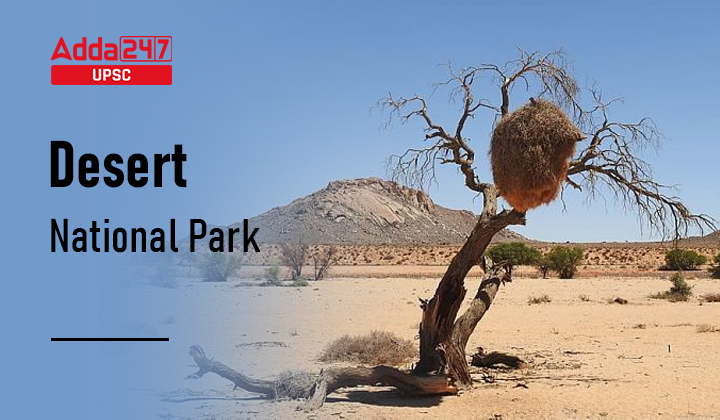Table of Contents
Desert National Park: Introduction
- The Desert National Park (DNP) covers an area of 3162 km² of which 1900 km² is in Jaisalmer district and remaining 1262 km² is in Barmer district of Rajasthan State.
- The area falls in the extreme hot and arid region of very low rainfall zone (<100mm) of the country.
- DNP was gazetted in the year 1980.
Desert National Park: Why in news?
- As Rajasthan shares the international border with Pakistan’s Sindh and Punjab provinces, it is suspected that the GIBs might have flown across to the neighboring country’s desert amid fears that they could become easy prey for the poachers there.
Desert National Park: Background
- The GIB was added to the world list of protected species of the ‘Convention on the Conservation of Migratory Species of Wild Animals’ during its 13th conference in Gandhinagar in 2020.
- Pakistan is a signatory to the Conference of the Parties (COP) to the convention.
Desert National Park: Know About Thar Desert
- The Thar Desert in north-western India is a unique and the only habitat of its type in the Indian subcontinent.
- The Aravalli hills mark the eastern-most boundary limit of the Thar desert while the western limit is defined by the fertile plains of the Indus.
- The Great Rann of Kutch forms a sharp boundary in the south while its northern limits are formed by the riparian sub-Himalayan plains.
Desert National Park: A Unique National Park in India
- DNP is spectacular representative of the desert ecosystem with exceptional beauty with endless expanse of sand, sand dunes, broken rock formations and an interesting array of unique flora and fauna.
- The DNP is the most important site for the long-term survival of the Globally Threatened Great Indian Bustard and other endemic fauna and flora.
- Other birds of significance include the endangered Oriental White-backed vulture Gyps bengalensis and Long-billed Gyps indicus, Stoliczka’s Bushchat Saxicola macrorhyncha, Green Munia Amandava formosa MacQueen’s or Houbara Bustard Chlamydotis maqueeni.
- Eleven bird species representative of Biome-13 have been identified by BirdLife International. The Thar desert is rich in herpetofauna, being the home of 11% of the 456 reptile species found in India.
- The prominent among them are Toad-headed Agama, Sindh Awl-headed Snake, Indian Spiny-tailed Lizard, Dwarf Gecko, Persian Gecko, Desert Monitor and Saw-scaled Viper.
Presence of fossils from the Jurassic Period
- One of the most interesting features of the Desert National Park is the presence of fossils from the Jurassic Period. The desert is several thousand years old.
- The Wood Fossil Park at Akal has significant fossil evidences dating back to the Jurassic period.
Haven for birds
- The park is a haven for migratory and desert’s resident birds. Mostly they are raptors. Avid birders come here to get a good look of the Short-toed eagle, tawny eagle, spotted eagle, laggar falcon and kestrel.
- These are the top birds of prey found in this region.
- It’s a great place to see demoiselle cranes and MacQueen’s bustard. But none of them are as famous and as important as the Critically endangered great Indian bustard.
Desert National Park: DNP is Home To GIB
- The GIB, which is the State bird of Rajasthan, is also considered India’s most critically endangered bird and is protected under the Wildlife Protection Act.
- Its population of about 150 in Rajasthan accounts for 95% of its total world population.
- The captive breeding of GIBs was taken up in the DNP through a project executed by the Dehradun-based Wildlife Institute of India in 2019.



 TSPSC Group 1 Question Paper 2024, Downl...
TSPSC Group 1 Question Paper 2024, Downl...
 TSPSC Group 1 Answer key 2024 Out, Downl...
TSPSC Group 1 Answer key 2024 Out, Downl...
 UPSC Prelims 2024 Question Paper, Downlo...
UPSC Prelims 2024 Question Paper, Downlo...





